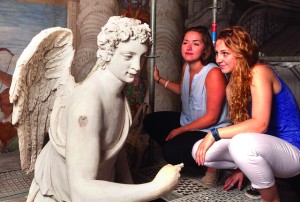Kayla Metelenis ’15 gazed around the church of San Sebastiano in amazement. There were moments when she was in disbelief at the beauty surrounding her on the walls and ceiling of the 16th-century church in Venice, Italy.
That was just a taste of what was to come during her Save Venice internship last summer. It wasn’t long before she got to stand on the scaffolding and see art conservators in action.

Kayla Metelenis ’15 and Genna Asselin ’15 examine a sculpture of Archangel Gabriel by Girolamo Campagna (1582) in the Monks’ Loft of the church of San Sebastiano.
“It was incredible to see the lines and little indentations of Paolo Veronese, who painted these works,” Metelenis says. “For someone who appreciates art, it’s unlike anything to see another person’s strokes up close. That was definitely my favorite part.”
Metelenis, who majored in art, joined classmate Genna Asselin ‘15, who double majored in art and chemistry, as the Lafayette College students chosen to spend two months in Venice, where they made visits to art restoration labs, watched conservators work and discussed their projects, saw works of art up close, wrote condition reports on works requiring conservation and helped catalog books and reports at Save Venice’s library.
“I got to do some things that some people will never get a chance to do,” Asselin says. “The public can’t open that door to the sacristy in San Sebastiano, or get up into the Monk’s Loft. We got so close to the frescoes up there, and there are frescoes where you can see he traced words onto the walls for what he wanted to paint. You were just struck by how unique the things we got to do were.”
Metelenis and Asselin were among a group of Lafayette students who applied for “The Mary ’79 and Howard Frank Internship in Art History,” which is funded by Mary Frank ‘79, who earned her Ph.D. in art history from Princeton University and is a scholar of Venetian art. In order to be considered, students must be Lafayette juniors majoring in art.
Part of the application process includes submitting a transcript and resumé, writing an essay on why the students want to take part in the internship, how it fits into future plans, and what the student hopes to contribute.
Diane Cole Ahl, Arthur J. ’55 and Barbara S. Rothkopf Professor of Art History at Lafayette, who selects the interns with her faculty colleagues, also takes into account the students’ academic and art history backgrounds, jobs they have had and volunteer work they may have completed. Many of those chosen will have already spent a semester studying in Italy (as Metelenis had).
“This is a very unique opportunity to have an internship like this when you’re this young and it is one that is subsidized,” Ahl says. “That’s what really distinguishes it. Venice is one of the premier art conservation sites in the world. This experience can change lives.”
That’s exactly what Frank, a vice president of Save Venice, was hoping would be the case when she decided to endow this internship, now in its fifth year, as she herself stood on the scaffolding in the church in Venice.
“It was like a light bulb went off,” she admits. “I had been talking to Diane Ahl, and suddenly I thought, If we fund interns and Lafayette students can go to work with Save Venice, then I’m fulfilling the needs of two institutions that are near and dear to me with one gift.”
